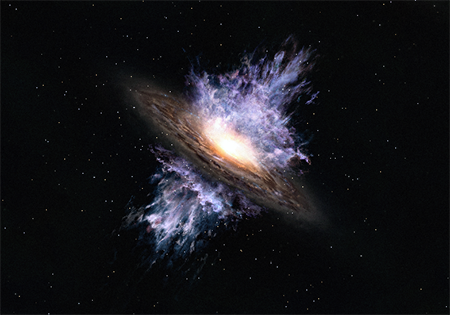| Jun 11, 2021 |
Astronomers discover earliest gigantic black hole storm
|
|
(Nanowerk News) Researchers using the Atacama Large Millimeter/submillimeter Array (ALMA) discovered a titanic galactic wind driven by a supermassive black hole 13.1 billion years ago. This is the earliest-yet-observed example of such a wind to date and is a telltale sign that huge black holes have a profound effect on the growth of galaxies from the very early history of the Universe.
|
|
At the center of many large galaxies hides a supermassive black hole that is millions to billions of times more massive than the Sun. Interestingly, the mass of the black hole is roughly proportional to the mass of the central region (bulge) of the galaxy in the nearby Universe.
|
|
At first glance, this may seem obvious, but it is actually very strange. The reason is that the sizes of galaxies and black holes differ by about 10 orders of magnitude. Based on this proportional relationship between the masses of two objects that are so different in size, astronomers believe that galaxies and black holes grew and evolved together (coevolution) through some kind of physical interaction.
|
|
A galactic wind can provide this kind of physical interaction between black holes and galaxies. A supermassive black hole swallows a large amount of matter. As that matter begins to move at high speed due to the black hole's gravity it emits intense energy, which can push the surrounding matter outward. This is how the galactic wind is created.
|
 |
| Artist’s impression of a galactic wind driven by a supermassive black hole located in the center of a galaxy. The intense energy emanating from the black hole creates a galaxy-scale flow of gas that blows away the interstellar matter that is the material for forming stars. (Image: ALMA (ESO/NAOJ/NRAO)
|
|
“The question is when did galactic winds come into existence in the Universe?” says Takuma Izumi, the lead author of the research paper ("Subaru High-z Exploration of Low-Luminosity Quasars (SHELLQs). XIII. Large-scale Feedback and Star Formation in a Low-Luminosity Quasar at z = 7.07") and a researcher at the National Astronomical Observatory of Japan (NAOJ). “This is an important question because it is related to an important problem in astronomy: how did galaxies and supermassive black holes coevolve?”
|
|
The research team first used NAOJ’s Subaru Telescope to search for supermassive black holes. Thanks to its wide-field observation capability, they found more than 100 galaxies with supermassive black holes in the Universe more than 13 billion years ago.
|
|
Then, the research team utilized ALMA's high sensitivity to investigate the gas motion in the host galaxies of the black holes. ALMA observed a galaxy HSC J124353.93+010038.5 (hereafter J1243+0100), discovered by the Subaru Telescope, and captured radio waves emitted by the dust and carbon ions in the galaxy.
|
|
Detailed analysis of the ALMA data revealed that there is a high-speed gas flow moving at 500 km per second in J1243+0100. This gas flow has enough energy to push away the stellar material in the galaxy and stop the star formation activity. The gas flow found in this study is truly a galactic wind, and it is the oldest observed example of a galaxy with a huge wind of galactic size. The previous record holder was a galaxy about 13 billion years ago; so this observation pushes the start back another 100 million years.
|
|
The team also measured the motion of the quiet gas in J1243+0100, and estimated the mass of the galaxy's bulge, based on its gravitational balance, to be about 30 billion times that of the Sun. The mass of the galaxy's supermassive black hole, estimated by another method, was about 1% of that. The mass ratio of the bulge to the supermassive black hole in this galaxy is almost identical to the mass ratio of black holes to galaxies in the modern Universe. This implies that the coevolution of supermassive black holes and galaxies has been occurring since less than a billion years after the birth of the Universe.
|
|
“Our observations support recent high-precision computer simulations which have predicted that coevolutionary relationships were in place even at about 13 billion years ago,” comments Izumi. “We are planning to observe a large number of such objects in the future, and hope to clarify whether or not the primordial coevolution seen in this object is an accurate picture of the general Universe at that time.”
|

